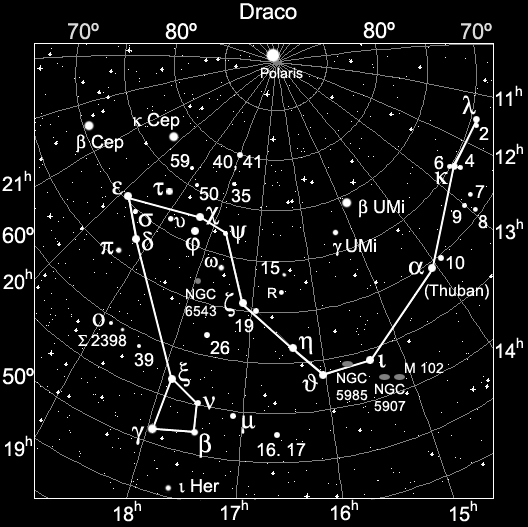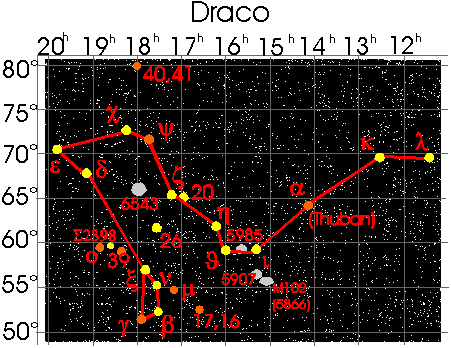
Draco lies between the two polar bears Ursa Major and Minor, wrapping itself around the North Pole (although upside down in Spring-Summer). While right-side up in mid-Autumn, the constellation may be too close to the horizon. The constellation is quite faint. Gamma is the only 2nd-magnitude star, other stars are 3rd-mag or fainter. Draco is a treasure-trove of exquisite binaries, many of which are suitable for binoculars. Thuban (alpha Draconis) is found by drawing a line from the tip of the Big Dipper's handle to the brightest star in the Little Dipper's bowl. Thuban is plum in the middle.

Alpha Draconis is Thuban (the Arabic name for the constellation). Thuban was the Pole Star around 2700 - 2800 BC, which has excited some Egyptologists into conjecturing about its possible association with the Great Pyramid of Khufu. Thuban is near the end of the dragon's tail. You can quickly find the star by drawing a line from the tip of the handle of the Big Dipper to beta UMi. The star is fairly isolated. While you're here, you can find the end of the dragon's tail. Kappa is located in the same manner (midpoint of a line from alpha UMa to beta UMi). Lambda, in the same field as kappa, is the tip of the tail. The opposite end -- the dragon's head -- is found by starting at Vega and moving a third of the distance to the bowl of the little dipper or three binocular fields toward the north pole.
Gamma Draconis is the constellation's brightest star at 2.2 visual magnitude. Named Eltanin -- from the Arabic Al Ras al Tinnin, ‘Dragon's Head’ -- the star is usually pictured as one of the ears. The head itself isn't clearly defined but beta (the second brightest star, ‘Rastaban’) is sometimes given as the eye, the head being seen in profile. The asterism is found by moving from Vega toward the bowl of the Little Dipper. One third this distance (about three and a half binocular fields) you'll encounter the Dragon's head. The entire head should fit into your FOV. In the same field, the star just north of beta (and opposite the FOV from gamma) is nu Draconis, considered one of the finest binocular doubles in all the heavens: 4.9, 4.9, 312º and separation 61.9".
Mu Draconis is a visual binary of nearly equal stars (5.7, 5.8) with an orbit of 482 years. The 2000.0 values are 18º and separation 2.2". The binary is just to the west of the dragon's head.
Omicron Draconis is a lovely binocular double with a colour contrast, an orange primary and blue companion: 4.7, 7.5. The position angle of the companion is 324º with a separation of 34.6". The binary is in the same field of view as 39 Draconis. Just west of omicron one degree and slightly north is a faint system whose two brightest components are both red dwarfs visible in small telescopes. The system is known as Struve 2398 and is one of the closest binaries at a distance of 11.3 light years: 8.9, 9.7, 170º and 13.6".
Psi Draconis is a binocular double of two yellow stars: 4.6, 5.8; PA 15º separation 30.3". You'll need to find 40 Draconis first. Place 40 Draconis at the top (northern edge) of your glasses and move them two degrees to the south. Psi will slide into view. For binary-chasers, another star here -- phi Draconis -- is a telescopic multiple: 4.5, 6.0; 271º and 0.5" with a third component 12.7, 116º and 72".

16 & 17 Draconis form a splendid binocular double: 5.4, 5.5, a position angle of 194º and separation 90.3". 17 Dra has its own telescopic companion, 6.5, PA 108º and separation 3.4". Place mu Draconis at the eastern edge of your glasses and 16, 17 Draconis will be near the opposite edge.
39 Draconis is a multiple system containing seven members. Most of these components are too faint or too close for binoculars but component C is ideal: 3.8, 5.1, position angle 21º and separation 89". To find 39 Draconis start at the Dragon's head. Now move xi Draconis to the opposite side and 39 slides into view. Another fine binary is in the same vicinity, one with a nice colour contrast is omicron Draconis.
40 and 41 Draconis form a binary of two cream-coloured stars: 5.7, 6.1; PA 231º and 19", perhaps too close for all but the largest binoculars. The system is at the far northern regions of Draco, just ten degrees from the North Celestial Pole and is easiest found starting at the Pole Star. Move down the Little Dipper to epsilon UMi (the second star on the handle). In the same FOV are 40 and 41 Draconis.